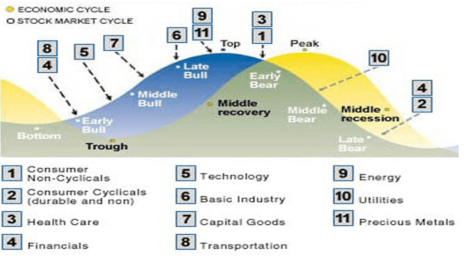With only a few weeks left in the year, it’s safe to say that 2024 has been great for investors.
The S&P 500 is up 27.8%, the Dow is higher by 15.6%, and the Nasdaq is the hands-down winner, having risen 36.5% so far this year.
But some sectors dragged those averages up, while others underperformed. And therein lies the advantage of sector investing.
To wit: if you invested in Communication Services (+38% this year) or Technology stocks (+25%), you probably did quite well. However, if you bought Health Care or Real Estate (up 2% and 6% respectively), you were probably second-guessing yourself. So, it’s important to be in tune with what stock market sectors are outperforming and which are lagging behind. But sector investing isn’t quite as simple as that.
So let’s dig a little deeper.
Free Report: 5 Best Stocks to Buy in April
Cabot Wealth Network’s expert analysts just revealed their 5 Best Stocks for April. Carefully selected for their combination of strong technical indicators and solid fundamentals, each one has the potential to go much higher in the coming weeks. Don’t miss out!
Free Report: 5 Best Stocks to Buy in April
Cabot Wealth Network’s expert analysts just revealed their 5 Best Stocks for April. Carefully selected for their combination of strong technical indicators and solid fundamentals, each one has the potential to go much higher in the coming weeks. Don’t miss out!
Free Report: 5 Best Stocks to Buy in April
Cabot Wealth Network’s expert analysts just revealed their 5 Best Stocks for April. Carefully selected for their combination of strong technical indicators and solid fundamentals, each one has the potential to go much higher in the coming weeks. Don’t miss out!
Free Report: 5 Best Stocks to Buy in April
Cabot Wealth Network’s expert analysts just revealed their 5 Best Stocks for April. Carefully selected for their combination of strong technical indicators and solid fundamentals, each one has the potential to go much higher in the coming weeks. Don’t miss out!
Sector Investing Advantages and Disadvantages
Some investors like to trade stocks based on their predictions for the economy, certain industries, or the market as a whole. Those focused on buying stocks in “bullish” sectors or industries will pay attention to the current economic cycles.
As you can see from the chart below, during certain market cycles, some sectors do better than others.
Fortunately, for investors trying to capture the biggest gains during the bullish periods, there are hundreds of sector mutual funds or exchange-traded funds (ETFs) from which to choose.
The list of available sector funds usually includes technology, financial, consumer cyclical, consumer staples, utilities, energy, natural resources, healthcare, real estate, and precious metals. But, note that each of these can be subdivided into even smaller sectors.
There is voluminous data on successful sector strategies, such as the huge gains from technology investing in the late 1990s and real estate investing in the early to mid-2000s. But we all know what happened to those sectors when technology went bust, and when the Great Recession hit. That’s the risk in sector investing. When the decline happens, it usually occurs quickly and is accompanied by significant drops.
You only need to look at the sector’s beta (volatility, as compared to the S&P 500) to ascertain the predicted volatility of the sector.
Beta: a measure of volatility relative to the broader market, as represented by the S&P 500, which has a beta of 1. A sector with a beta of 1 has historically exhibited the same level of volatility as the market. A sector with a beta less than 1 has historically exhibited less sensitivity to market moves, while a sector with a beta greater than 1 has exhibited more sensitivity to market moves.
The advantage to sector investing is diversification using a professional manager when you are not well-versed on a particular industry, as well as the potential for substantial gains when that sector excels. But the downside is significant risk, should you be on the wrong side of the bet.
For prudent investors, you might consider adding sector investing to your portfolio, but keep the allocation to maybe 5% of your holdings for each sector. You can also diversify by employing certain sectors for longer-term investing (those that are least volatile) and others for your short-term, more speculative funds.
Learn from Expert Analyst Nancy Zambell
Nancy Zambell has spent 30 years educating and helping individual investors navigate the minefields of the financial industry. As a lecturer and educator, Nancy has led seminars for individual investors at the National Association of Investors, Investment Expo and the Money Show. She has also taught finance, economics and banking at the college level, and has been quoted extensively in The Wall Street Journal, Investor’s Business Daily, USA Today, and BusinessWeek. Now let her give you the tools and resources, including a monthly magazine, for gaining the peace-of-mind to live comfortably now and in retirement in her Cabot Money Club.
Learn More
Learn from Expert Analyst Nancy Zambell
Nancy Zambell has spent 30 years educating and helping individual investors navigate the minefields of the financial industry. As a lecturer and educator, Nancy has led seminars for individual investors at the National Association of Investors, Investment Expo and the Money Show. She has also taught finance, economics and banking at the college level, and has been quoted extensively in The Wall Street Journal, Investor’s Business Daily, USA Today, and BusinessWeek. Now let her give you the tools and resources, including a monthly magazine, for gaining the peace-of-mind to live comfortably now and in retirement in her Cabot Money Club.
Learn More
Learn from Expert Analyst Nancy Zambell
Nancy Zambell has spent 30 years educating and helping individual investors navigate the minefields of the financial industry. As a lecturer and educator, Nancy has led seminars for individual investors at the National Association of Investors, Investment Expo and the Money Show. She has also taught finance, economics and banking at the college level, and has been quoted extensively in The Wall Street Journal, Investor’s Business Daily, USA Today, and BusinessWeek. Now let her give you the tools and resources, including a monthly magazine, for gaining the peace-of-mind to live comfortably now and in retirement in her Cabot Money Club.
Learn More
Learn from Expert Analyst Nancy Zambell
Nancy Zambell has spent 30 years educating and helping individual investors navigate the minefields of the financial industry. As a lecturer and educator, Nancy has led seminars for individual investors at the National Association of Investors, Investment Expo and the Money Show. She has also taught finance, economics and banking at the college level, and has been quoted extensively in The Wall Street Journal, Investor’s Business Daily, USA Today, and BusinessWeek. Now let her give you the tools and resources, including a monthly magazine, for gaining the peace-of-mind to live comfortably now and in retirement in her Cabot Money Club.
Learn More










